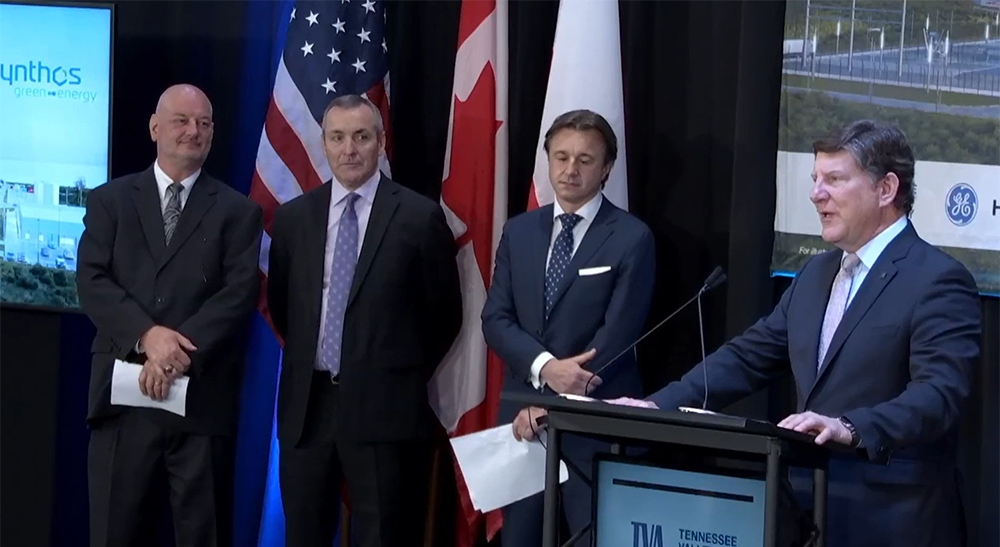Markets and Reliability Committee
PJM Gives Update on December Winter Storm Report
VALLEY FORGE, Pa. — Adam Keech, PJM vice president of market design, told the Markets and Reliability Committee last week that the RTO is delaying its estimation of when it will be publishing a report on the December winter storm to July.
In committee meetings following the storm, also known as Winter Storm Elliott, PJM initially stated that it was planning to release the report in April. But Keech said that staff are diverting resources to a data request related to the storm from NERC and FERC, followed by a visit from the two organizations in April. Staff are also working to address a list of compliance filings FERC required in its conditional approval of PJM’s proposal to allow aggregated distributed energy resources to participate in its markets.
The report will likely be structured similarly to the paper PJM released following the 2014 polar vortex, with chapters on generation performance and gas availability, load forecasting, timing and criteria for emergency procedures, Capacity Performance, dispatch, and the cost offer verification process.
In the meantime, Keech said PJM plans to provide lessons learned from the storm during stakeholder meetings in mid-May, focusing on the capacity market to inform changes being considered through the Critical Issues Fast Path (CIFP) process. He said many of the major items that will likely be presented have already been under stakeholder discussion even before the December storm. (See PJM Board Initiates Fast-track Process to Address Reliability.)
“We’ve been working on many of the issues you will see already for the past year,” he said.
Stakeholders Support New Default CONE and ACR Values
Both the MRC and Members Committee supported the proposed default cost of new entry (CONE) and avoidable-cost rate (ACR) through advisory votes. The changes are now set to be filed with FERC, with the goal of being in place for the 2026/27 delivery year. PJM elected for a same-day vote for the MRC and MC to give the Board of Managers more time to review the information before the filing. (See “Updated Default CONE and ACR Figures,” PJM MRC/MC Briefs: Feb. 23, 2023.)
The gross CONE values for all resource types, except storage, would increase, which PJM’s Skyler Marzewski said is largely because of changes to investment tax credits under the Inflation Reduction Act. The CONE changes also include new reference resources for combined cycle and onshore wind resources.
The most significant changes to ACRs include adding steam oil and gas as a new default unit type, including more data from the Nuclear Energy Institute for calculating nuclear costs and refined estimates of property taxes and insurance costs. All gross ACR values increased except single-reactor nuclear facilities.
PJM, Monitor Present Renewable Dispatch Proposal
Joel Romero Luna of Monitoring Analytics and PJM’s Darrell Frogg presented a first read of a joint proposal to create new dispatch protocols for renewable resources, with the aim of increasing visibility of what level renewables can be reduced to. Frogg said as more intermittent resources come online, it is likely that there will be more dispatch required, and those resources will not be able to provide their maximum output whenever they are available.
The proposal would use basepoints currently available through the Inter-Control Center Communications Protocol (ICCP) rather than curtailment flags, and intermittent resources would be directed to follow their economic basepoints even when they are curtailed because of the prevalence of inadvertent curtailments. Resources would be required to update critical parameters in real-time security-constrained economic dispatch (SCED) every five minutes and on an hourly basis for parameters in intermediate-term SCED cases.
The current lost opportunity cost (LOC) structure for wind resources would be extended to solar generators, making them eligible for LOC when they follow SCED dispatch and have the ability to receive instructions from PJM.
Frogg said the proposal is an effort to require intermittents to offer their median or expected output into the day-ahead market, based on forecasts of both weather and equipment availability.
Responding to stakeholder questions, Luna clarified that there is currently a requirement that units must offer into the market, and while most intermittents already follow the practice being proposed, there is insufficient clarity in the manuals codifying the process.
Economist Roy Shanker questioned how generators’ forecasts will be reviewed for accuracy by PJM, saying that outside forecasts should be checked for accuracy to avoid a bias being developed.
Monitor Joe Bowring said they believe the right amount of review is already included in the proposal and no further changes are needed.
Members Committee
Deficiency Notice Interrupts Timeline on CP Penalty Payments
Just the day before the committee meetings, FERC issued a deficiency notice on PJM’s filing to allow market participants that have defaulted to continue operating in its markets under certain conditions, including their contribution to reliability, the ability to generate revenues in the future and capability to post collateral (ER23-1058).
A fourth factor recognizes that certain transmission customers cannot have their service terminated without FERC approval. (See “1st Read on Proposal to Allow Flexibility for Market Participation During Defaults,” PJM MRC Briefs: Nov. 16, 2022)
The notice “is of concern for those following Winter Storm Elliott, because we are getting ready in April to send out the invoices for the Capacity Performance penalties,” PJM General Counsel Chris O’Hara told the MC.
In its response to the notice, filed Thursday, the RTO said it had accidentally included the last four words in the phrase, “PJM may permit a defaulting market participant to continue to participate in PJM markets in a limited manner,” in the proposed revisions to the Operating Agreement; they had been in an early draft but deemed too vague — as FERC noticed — and were meant to be removed.
PJM also stated that the four factors it identified consisted of an exhaustive list of the circumstances under which it would allow market participants to continue operating while in default.
The RTO asked FERC to implement a shortened five-day comment period and to rule on the proposal by April 7, with an effective date of April 8.
“PJM requested these dates purposefully,” the RTO said in its response. “PJM is required to issue the March monthly bill by April 7, 2023. Those monthly bills will include any nonperformance charges related to Winter Storm Elliott. The aggregate nonperformance charge will be between $1 [billion] to $2 billion. While PJM has proactively acted to reduce the risk of capacity market seller default by proposing to amend the manner in which the Winter Storm Elliott nonperformance charges may be billed, the risk of default will remain, even if those revisions are accepted,” referring to a separate filing that would allow market participants to opt to make their payments over a longer period.
O’Hara said PJM is concerned about the possibility of defaults stemming from the nonperformance charges, not just in terms of the absolute number of megawatts affected, but also the potential for generators providing critical services such as black start or critical load units being at risk. Should owners of those facilities be considering default, he said PJM wants a conversation to be opened so that they can seek a waiver request at FERC to allow them to continue operating.
Stakeholders Question CIFP Process
Steven Lieberman of American Municipal Power said he believes the PJM board has not met the requirements for initiating the CIFP process that it began in February, arguing that it has not set a firm deadline for resolving the issue.
While the board has identified Oct. 1 as the date for PJM to make a filing to address reliability concerns identified in about five years, Lieberman argued that the deadline is arbitrary. (See PJM, Stakeholders Present Initial Capacity Market Proposals to RASTF)
“It’s our opinion at least that it doesn’t satisfy the requirements for starting the CIFP process in the first place. … We think this process was elected in a way that conflicts with Manual 34,” he said.
Lieberman also said the board’s letter opening the CIFP is vague and does not lay out a process that fosters the kind of open and transparent dialogue that the letter states the board hopes to have with stakeholders as they create proposals. He noted that stakeholders had requested that the board attend future MRC or MC meetings to speak about the scope it envisioned for CIFP proposals and what its largest concerns are, but that PJM determined it would not be proper to have individual members potentially speaking on behalf of the entire board.
Greg Poulos, of the Consumer Advocates of the PJM States (CAPS), said generator performance is the key issue for many state advocates, but he believes it will be hard to create a proposal addressing the issue when the data on performance during Elliott won’t be available until July.
“When you look at what our dates are and what we’re trying to achieve, it is hard to match it up,” he said.
Susan Bruce, representing the PJM Industrial Customer Coalition, agreed that the deadlines are optimistic, and attempting to address too many portions of the capacity market on a short time frame may prove difficult. She said stakeholders should have a disciplined mindset rather than allow the process to become “an invitation for a Christmas tree.”
Erik Heinle, Vistra’s director of PJM market policy, said he believes the board letter was well written and provides enough clarity on the areas it believes that proposals must address, while also leaving stakeholders discretion to include other topics as well. He noted that any issues not addressed by the CIFP could be open for continued discussion through the Resource Adequacy Senior Task Force, which is currently on hiatus through the CIFP deliberations.
Other Stakeholder Discussions
MC Chair David “Scarp” Scarpignato said stakeholders are considering whether to start MC meetings earlier on days when the MRC adjourns significantly earlier than scheduled. He said that in some cases, stakeholders must wait for hours before the MC starts. Those with comments or suggestions were encouraged to reach out to Scarp or PJM Director of Stakeholder Affairs David Anders.
The MRC tabled a vote on proposed revisions to Manual 11: Energy & Ancillary Services Market Operations because of amendments offered in an attempt to better align the manual with PJM’s other governing documents. Monitor Bowring and some stakeholders suggested that the proposed changes to the revisions may be substantive at first glance and it would be better to wait a month to review before taking a vote.

